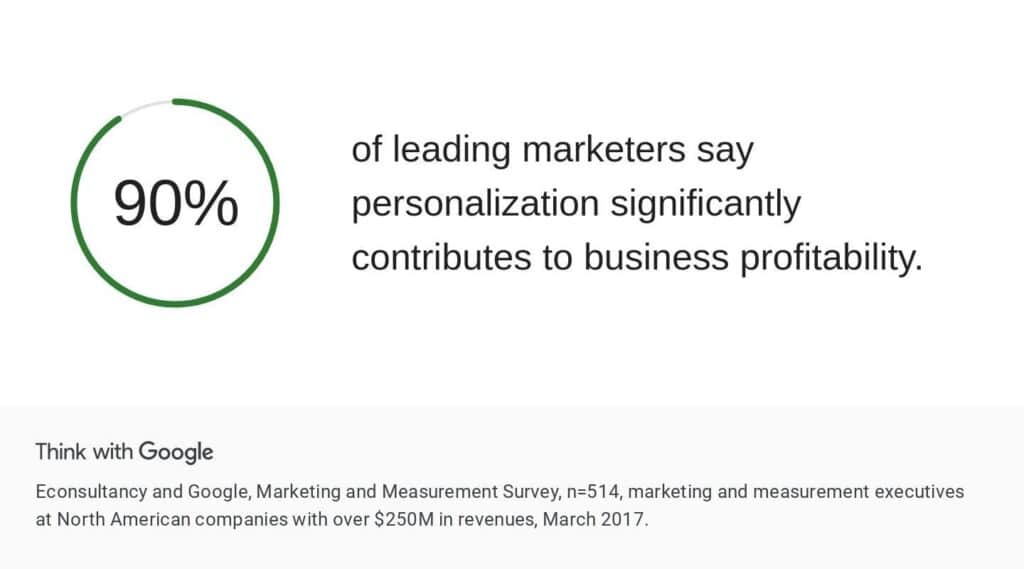Today, customers demand personalization. According to a 2021 McKinsey survey, 75% of consumers stated that personalization made them more likely to repeatedly buy from a brand and recommend that brand to others.
Consumers are more likely to buy from brands that remember them or use purchase history to make recommendations.
To add, the majority of marketers believe personalization drives profitability too. A recent survey from Think with Google stated that leading marketers believe personalization significantly contributes to profitability.

Clearly it’s important, but what makes personalization such an important part of the sales process?
- Customers expect it: 75% of customers are frustrated when they don’t receive personalization
- When customers receive personalization, they’re more engaged in the sales process
- Personalization shows your sales team whether their message resonates with customers
- Personalization boosts customer conversion rates and average order values
- Customers find it easier to trust the brands that understand them
- There’s a marked decrease in churn rates over time
Personalizing an Automated Sales Process:
When it comes to automations and your CRM, there are two different types of automations you can create:
- Data-based: these automations are designed to run whenever data is created, updated, or deleted. For example, you may want to create a task (action) whenever a new person record is created (trigger).
- Time-based: these automations will run based on system or custom date fields. You can choose to have an action occur a certain number of days before/ after the date hosted in the field or on the exact date. An example of a time-based automation would be: to update a custom field (action) one day after a deal’s Actual Close Date is set (trigger).
With an automated sales workflow, you can close leads at scale. You can handle a tremendous amount of lead volume with time to spare, which is ideal because it gives you the opportunity to personalize your communication.
Now, how do you balance automation and personalization? Here are four tips to consider:
Tip 1: Automate Administrative and Non-Billable Work
Your sales team should be primarily focused on closing deals with customers. If your sales reps aren’t prospecting, they should be closing deals. They shouldn’t be focused on creating brochures or writing proposals.
Let’s take a look at the tasks we can automate.
| Tasks | Automate Tasks With … |
| Manage the customer relationship in Excel | Automate the customer relationship with Pipeline CRM |
| Prospecting and customer research in Google | Prospect research automation with Lusha |
| Scheduling meetings with clients | Schedule meetings with Calendly |
| Scheduling web/phone conferences manually | Automatically schedule conferences with DialPad |
| Writing proposals in Google Docs | Use Panda Doc to automate proposal creation |
| Requesting reviews from customers directly | Automate review management with Grade.us |
| Work with multiple software tools | Integrate tools into a central dashboard with Zapier |
| Sending emails to prospects via Google Workspace | Automate email messaging with Pipeline CRM |
| Document management | Automated document management with Pipeline CRM |
This isn’t a comprehensive list, but you see how much time tools can take off your hands. If your sales teams are still handling these tasks manually, they’re spending (wasting) time on administrative tasks that are costing you.
Tip 2: Create Templates to Customize
Templates are essential personalization tools. Personalization is much easier and more efficient if you start from a template. There’s no need to think about what to say, when, or who to say it to. If you’re working with templates, legal can check them beforehand. You can even ask for specific guidance on customizing each template beforehand.
Here’s a short list you can use to get started.
- Sales introduction email template
- Website lead response template
- Recent activity voicemail template
- Rapport builder templates (x3)
- Mutual friend template
- Re-establishing a connection template
- Voicemail ‘Sorry I missed you’ template
- Triggering event email templates
- Anniversary/celebration templates
- Customer demo request response template
- Thanks for downloading response template
- Free trial request template
- Customer onboarding introduction template
- Customer ghosting response template
- No response/engagement template (x3)
- Are you still interested? template
- Content compliment template
- Out-of-office reply template
- Great to connect with you template
- LinkedIn connection request template
Use these templates (with mail merge, for example) to semi-automate the personalization process and to customize your sales process.
Tip 3: Collect the Customer Data you Need to Personalize Your Sales Process
What customer data do you need to personalize your sales process? The list is pretty straightforward.
- Notable events (birthdays)
- Purchase history
- Product/service consumption rates
- The state of your company
- The financials of your company
- Customer revenue
- Customer spending
- Profit margin (per customer)
- Purchase frequency
- Company history
- Objections
- Risk factors
- Desires, goals, fears, frustrations
- Problems
Need more information? Look for the customer data you need.
Tip 4: Use Software Tools to Personalize Parts of the Sales Process
Believe it or not, you can use your automations and integrations to personalize the sales process.
| Automation | Personalize the Sales Process By … |
| Automate the customer relationship with Pipeline CRM | Using CRM data to follow up with customers and build the relationship |
| Prospect research automation with Lusha | Showing customers you’ve done your homework |
| Schedule meetings with Calendly | Adding customer data to your Calendly events |
| Automatically schedule conferences with DialPad | Sending customers a customized meeting agenda (template) |
| Use Panda Doc to automate proposal creation | Using Lusha, Panda Doc, and your templates to customize proposals for customers |
| Automate review management with Grade.us | Using your review request templates to send out a sincere request |
| Integrate tools into a central dashboard with Zapier | Pulling data from your integrations into your CRM. Use your shared data to improve customer service |
| Automate email messaging with Pipeline CRM | Create broadcast and autoresponder sequences that are oriented around triggering events |
| Automated document management with Pipeline CRM | Use email templates to share important docs with customers |
Did you catch the formula?
Customer Data + (Automation * Templates) = Personalization
This formula is straightforward. Use it to humanize an automated sales process
Final Thoughts
If you’re looking for a way to personalize your sales process at scale, start with your CRM.
Free up time for selling and engaging your leads across multiple channels for greater success. Allow your sales team to focus on their most valuable tasks and 10x sales revenue. Learn more about our CRM features for effective sales team management.




